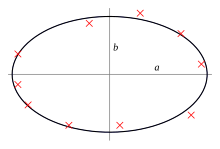
Back Kleinstekwadratemetode Afrikaans مربعات دنيا Arabic Ən kiçik kvadratlar üsulu Azerbaijani Метод на най-малките квадрати Bulgarian Mètode dels mínims quadrats Catalan Metoda nejmenších čtverců Czech Mindste kvadraters metode Danish Methode der kleinsten Quadrate German Mínimos cuadrados Spanish Vähimruutude meetod Estonian
| Part of a series on |
| Regression analysis |
|---|
| Models |
| Estimation |
| Background |


The method of least squares is a parameter estimation method in regression analysis based on minimizing the sum of the squares of the residuals (a residual being the difference between an observed value and the fitted value provided by a model) made in the results of each individual equation.
The most important application is in data fitting. When the problem has substantial uncertainties in the independent variable (the x variable), then simple regression and least-squares methods have problems; in such cases, the methodology required for fitting errors-in-variables models may be considered instead of that for least squares.
Least squares problems fall into two categories: linear or ordinary least squares and nonlinear least squares, depending on whether or not the model functions are linear in all unknowns. The linear least-squares problem occurs in statistical regression analysis; it has a closed-form solution. The nonlinear problem is usually solved by iterative refinement; at each iteration the system is approximated by a linear one, and thus the core calculation is similar in both cases.
Polynomial least squares describes the variance in a prediction of the dependent variable as a function of the independent variable and the deviations from the fitted curve.
When the observations come from an exponential family with identity as its natural sufficient statistics and mild-conditions are satisfied (e.g. for normal, exponential, Poisson and binomial distributions), standardized least-squares estimates and maximum-likelihood estimates are identical.[1] The method of least squares can also be derived as a method of moments estimator.
The following discussion is mostly presented in terms of linear functions but the use of least squares is valid and practical for more general families of functions. Also, by iteratively applying local quadratic approximation to the likelihood (through the Fisher information), the least-squares method may be used to fit a generalized linear model.
The least-squares method was officially discovered and published by Adrien-Marie Legendre (1805),[2] though it is usually also co-credited to Carl Friedrich Gauss (1809),[3][4] who contributed significant theoretical advances to the method,[4] and may have also used it in his earlier work in 1794 and 1795.[5][4]
- ^ Charnes, A.; Frome, E. L.; Yu, P. L. (1976). "The Equivalence of Generalized Least Squares and Maximum Likelihood Estimates in the Exponential Family". Journal of the American Statistical Association. 71 (353): 169–171. doi:10.1080/01621459.1976.10481508.
- ^ Mansfield Merriman, "A List of Writings Relating to the Method of Least Squares"
- ^ Bretscher, Otto (1995). Linear Algebra With Applications (3rd ed.). Upper Saddle River, NJ: Prentice Hall.
- ^ a b c Stigler, Stephen M. (1981). "Gauss and the Invention of Least Squares". Ann. Stat. 9 (3): 465–474. doi:10.1214/aos/1176345451.
- ^ Plackett, R.L. (1972). "The discovery of the method of least squares" (PDF). Biometrika. 59 (2): 239–251.
© MMXXIII Rich X Search. We shall prevail. All rights reserved. Rich X Search